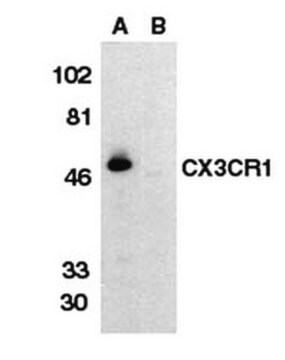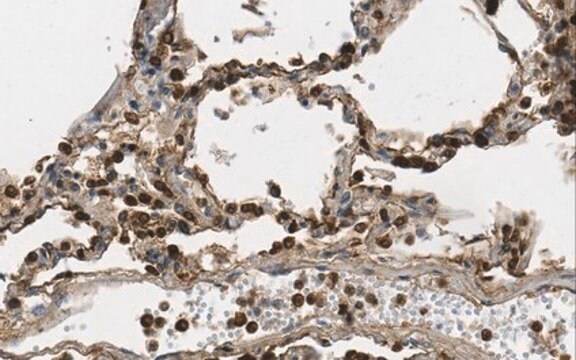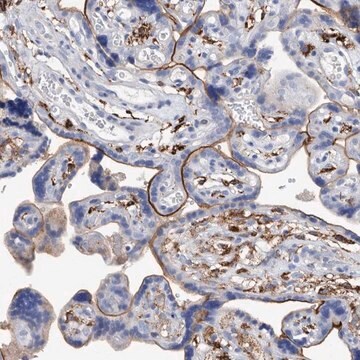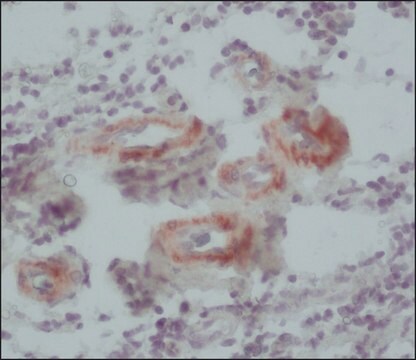추천 제품
생물학적 소스
mouse
Quality Level
항체 형태
purified antibody
항체 생산 유형
primary antibodies
클론
DD/A11, monoclonal
mAbA11, monoclonal
종 반응성
human, bovine, mouse
종 반응성(상동성에 의해 예측)
rat
제조업체/상표
Chemicon®
기술
ELISA: suitable
immunocytochemistry: suitable
immunohistochemistry: suitable
western blot: suitable
동형
IgG2a
NCBI 수납 번호
UniProt 수납 번호
배송 상태
wet ice
타겟 번역 후 변형
glycosylation
유전자 정보
human ... AGER(177)
일반 설명
RAGE (Receptor for Advanced Glycosylation End Products) is a 35 kDa cell surface receptor that binds molecules modified by advanced glycation end products (AGEs), an irreversible non-enzymatic reaction occuring from the interaction of proteins and lipids with glucose. The increased expression of RAGE is associated with many disorders, such as diabetic vasculopathy, neuropathy, retinopathy and neuropathy, Alzheimer’s disease and immune/inflammatory reactions of the vessel walls. AGE/RAGE accumulates at sites of vascular disease in diabetes, but blockade of RAGE suppresses development of atherosclerosis and vascular disorders. RAGE binds to amyloid beta, which is overproduced in neurons and vessels in Alzheimer′s disease, and this interaction results in oxidative stress leading to neuronal degeneration.
특이성
RAGE (Receptor for Advanced Glycosylated End Products). The antibody recognizes both natural and recombinant RAGE.
면역원
Recombinant truncated extracellular part of RAGE produced in E. coli.
애플리케이션
Anti-RAGE Antibody, clone DD/A11 or A11 is an antibody against RAGE for use in ELISA, IC, IH & WB.
Immunohistochemistry:
A previous lot of this antibody was shown to be reactive on paraffin embedded tissue sections.
Immunocytochemistry:
A previous lot was shown to work on cells fixed with ice cold acetone using a Cy3 conjugated secondary antibody.
ELISA:
A previous lot was shown to work on direct ELISA.
Immunoblotting:
Recognizes a band of ~48kDa in bovine lung extract.
Optimal working dilutions must be determined by end user.
A previous lot of this antibody was shown to be reactive on paraffin embedded tissue sections.
Immunocytochemistry:
A previous lot was shown to work on cells fixed with ice cold acetone using a Cy3 conjugated secondary antibody.
ELISA:
A previous lot was shown to work on direct ELISA.
Immunoblotting:
Recognizes a band of ~48kDa in bovine lung extract.
Optimal working dilutions must be determined by end user.
품질
Routinely evaluated by Western Blot on Mouse Brain lysates.
Western Blot:
1:500 dilution of this lot detected RAGE on 10 μg of Mouse Brain lysates.
Western Blot:
1:500 dilution of this lot detected RAGE on 10 μg of Mouse Brain lysates.
표적 설명
48 kDa
물리적 형태
Format: Purified
Purified mouse monoclonal IgG2a in buffer containing 0.02 M phosphate buffer, 0.25 M NaCl, and 0.1% sodium azide.
분석 메모
Control
Lung tissue, mouse brain lysate.
Lung tissue, mouse brain lysate.
기타 정보
Concentration: Please refer to the Certificate of Analysis for the lot-specific concentration.
법적 정보
CHEMICON is a registered trademark of Merck KGaA, Darmstadt, Germany
적합한 제품을 찾을 수 없으신가요?
당사의 제품 선택기 도구.을(를) 시도해 보세요.
Storage Class Code
10 - Combustible liquids
WGK
WGK 2
Flash Point (°F)
Not applicable
Flash Point (°C)
Not applicable
시험 성적서(COA)
제품의 로트/배치 번호를 입력하여 시험 성적서(COA)을 검색하십시오. 로트 및 배치 번호는 제품 라벨에 있는 ‘로트’ 또는 ‘배치’라는 용어 뒤에서 찾을 수 있습니다.
Cardiovascular diabetology in the core of a novel interleukins classification: the bad, the good and the aloof.
Enrique Z Fisman, Michael Motro, Alexander Tenenbaum
Cardiovascular Diabetology null
Rosaria Bassi et al.
Journal of neuro-oncology, 87(1), 23-33 (2007-11-03)
HMGB1 (high mobility group box 1 protein) is a nuclear protein that can also act as an extracellular trigger of inflammation, proliferation and migration, mainly through RAGE (the receptor for advanced glycation end products); HMGB1-RAGE interactions have been found to
Anna Kamynina et al.
Journal of cellular physiology, 236(9), 6496-6506 (2021-02-12)
The receptor for advanced glycation end products (RAGE) is a signal receptor first shown to be activated by advanced glycation end products, but also by a variety of signal molecules, including pathological advanced oxidation protein products and β-amyloid. However, most
Autocrine S100B effects on astrocytes are mediated via RAGE.
Gerald Ponath, Christiane Schettler, Florian Kaestner, Bjorn Voigt, Dennis Wentker et al.
Journal of Neuroimmunology null
Alternatively spliced RAGEv1 inhibits tumorigenesis through suppression of JNK signaling.
Kalea, Anastasia Z, et al.
Cancer Research, 70, 5628-5638 (2010)
자사의 과학자팀은 생명 과학, 재료 과학, 화학 합성, 크로마토그래피, 분석 및 기타 많은 영역을 포함한 모든 과학 분야에 경험이 있습니다..
고객지원팀으로 연락바랍니다.








